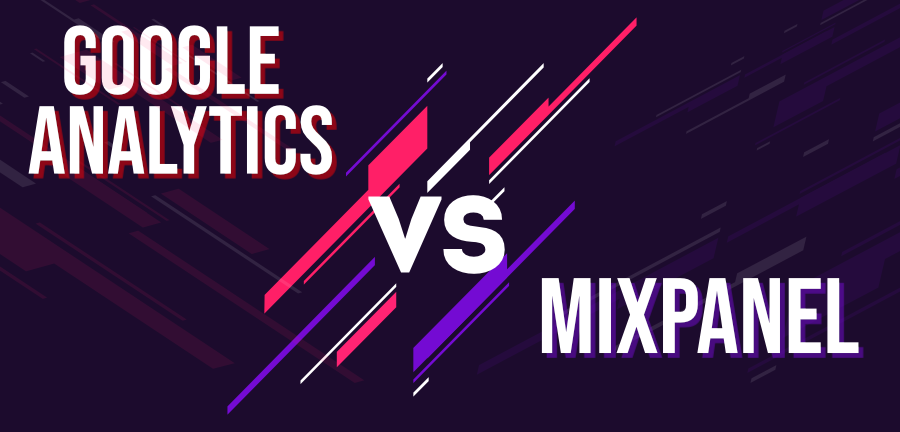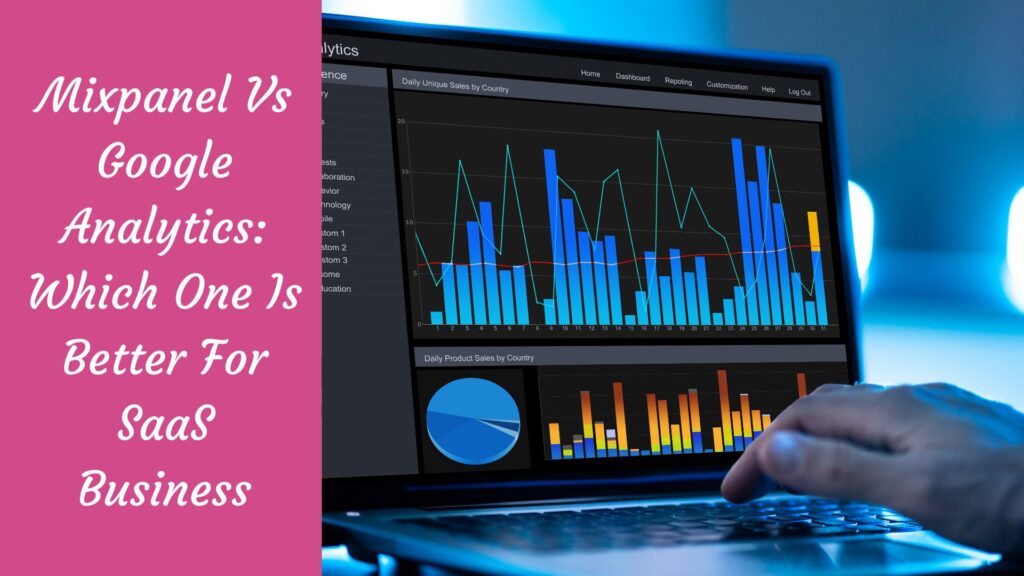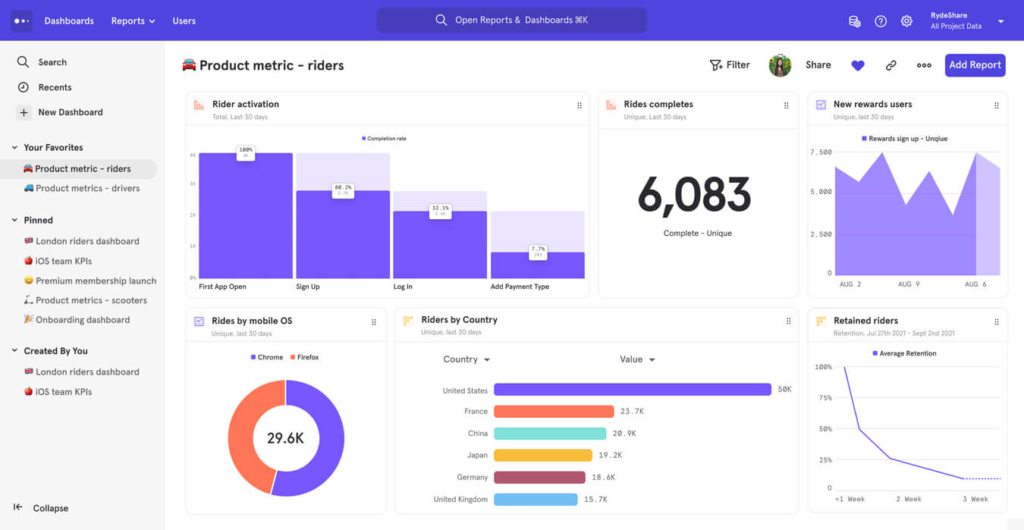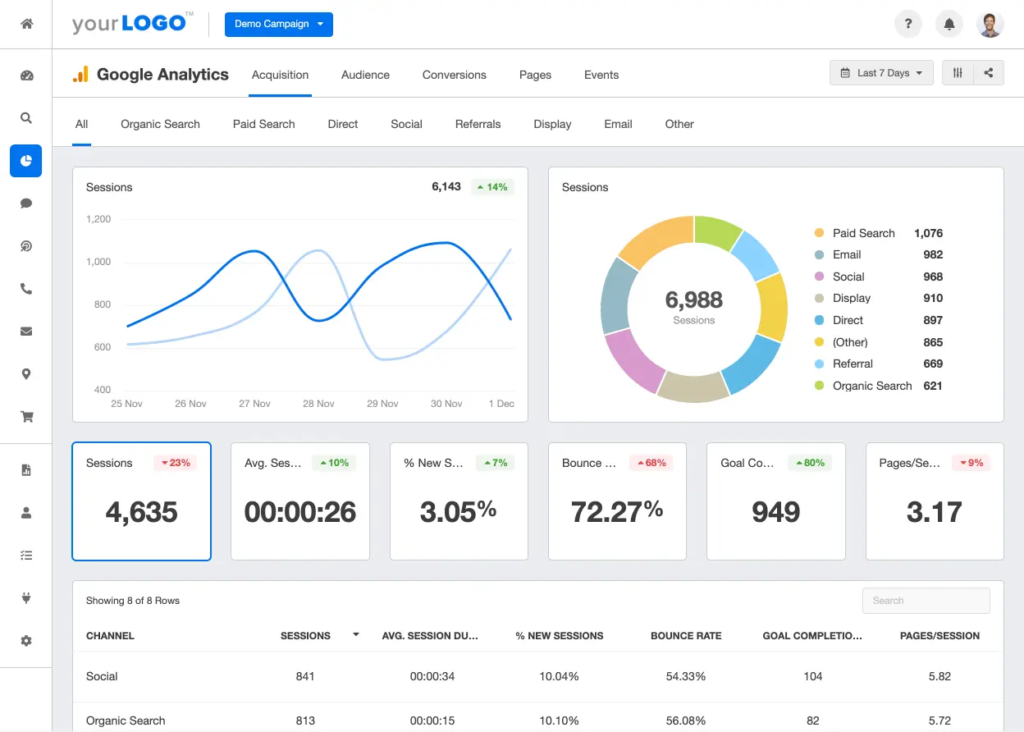In the fast-paced world of SaaS businesses, understanding your users isn’t just nice to have; it’s crucial.
Imagine you have an amazing product, but you’re flying blind, not knowing what features your users love or where they get stuck.
That’s where powerful tools like Mixpanel and Google Analytics come into play. They are like high-powered flashlights in the dense forest of data, showing you the path to user happiness and product success.
The problem is, that many SaaS companies struggle to pick the right tool. Our blog lights up this path, comparing Mixpanel and Google Analytics side by side, helping you make an informed choice, fast. Say goodbye to guesswork and hello to growth!
Understanding Mixpanel
Overview of Mixpanel
Mixpanel takes analytics to the next level, primarily focusing on user interaction with your product.
Unlike traditional tools that track page views or sessions, Mixpanel keeps an eye on the actions users take, such as clicking a button or completing a purchase. This action-oriented approach gives you a microscope to observe the finer details of user engagement, making it a game-changer for SaaS businesses striving for growth.
Key Features of Mixpanel
- User Behavior Tracking: Imagine knowing exactly how users interact with your app, from the moment they sign up. Mixpanel does this effortlessly, tracking every touch, click, or swipe.
- Funnel Analysis: It’s like observing users navigating a maze. Mixpanel’s funnel analysis shows where users drop off in their journey, helping you pinpoint and fix leaks.
- User Segmentation: Group your users based on actions they’ve taken. For instance, you can distinguish between those who’ve made a purchase and those who haven’t, tailoring your strategies accordingly.
- A/B Testing: This is where Mixpanel shines. Test different features with different user groups and stick with what works best, all within Mixpanel’s dashboard.
- Retention Analysis: It’s not just about acquiring users; it’s about keeping them. Mixpanel helps you understand what keeps users coming back, or what drives them away.
Benefits of Using Mixpanel for SaaS Businesses
- User-Centric Insights: With its focus on actions, Mixpanel allows you to understand the ‘why’ behind user behaviors, offering insights beyond page views or session lengths.
- Enhanced Decision Making: By knowing precisely where users stumble or disengage, you can make informed decisions to improve the user experience and boost retention.
- Tailored User Engagement: Segmentation and A/B testing empower you to personalize user experiences, significantly increasing the chances of conversion and repeat engagement.
- Growth Tracking: The detailed analysis provides a clear picture of growth drivers, enabling you to scale your SaaS business effectively.
Mixpanel provides a comprehensive, action-oriented analytics solution that can significantly enhance user understanding and engagement for SaaS businesses. By leveraging its detailed analysis and user-centric insights, companies can streamline their strategies, fostering growth and success.
Understanding Google Analytics
Overview of Google Analytics
Google Analytics is like the Swiss Army knife for anyone looking to get a handle on their website’s performance.
Free and user-friendly, it offers a comprehensive view of who’s visiting your site, what they’re doing, and how they found you in the first place. Tailor-made for businesses aiming to maximize their online presence, it’s especially pivotal for SaaS businesses where understanding digital footprint translates directly to growth.
Key Features of Google Analytics
Traffic Reporting: Think of this as the 10,000-foot view of your website traffic. Google Analytics shows where your users are coming from, be it search engines, social media platforms, or direct visits. Learn more about traffic reporting.
Audience Information: Get to know your visitors. This feature provides demographics (age, gender), interests, location, and even the devices used to access your site. Deep-dive into audience insights.
Conversion Tracking: It’s all about figuring out what happens after a customer clicks. Whether signing up for a newsletter or purchasing a subscription, Google Analytics helps you track these conversions to understand what’s working. Start conversion tracking.
Behavior Flow: This tells you the story of your user’s journey through your site. It’s like mapping their steps from entry to exit, helping you pinpoint where they get engaged and where they drop off. Explore behavior flow.
Real-time Reporting: Want to know what’s happening on your site right this second? Real-time reporting has your back, offering immediate insights into active users and their activities. Check real-time data.
Benefits of Using Google Analytics for SaaS Businesses
- Enhanced User Understanding: Layered information about your audience arms you with the knowledge to tailor your product and marketing for your target demographic.
- Optimize Conversion Pathways: By knowing where users are dropping off, you can finetune your site’s user experience to increase conversions.
- Real-Time Feedback Loop: Instant insights allow you to test and adjust your strategies on the fly, perfect for SaaS businesses where agility is key.
- Cost-Effective Scaling: Being free and packed with features, Google Analytics offers unbeatable value, helping small-to-midsize SaaS outfits conserve resources while optimizing their digital strategy.
Google Analytics gives SaaS businesses a powerful, cost-effective toolkit to dissect and improve their online presence. With its deep dives into user behavior, traffic sources, and real-time on-site action, teams can refine their offerings and strategies to better meet user needs and drive growth.
Comparing Mixpanel Vs Google Analytics

When it comes to measuring the success and understanding the behavior of users on a digital platform, both Mixpanel and Google Analytics offer robust solutions. However, their key features, ease of use, and overall approach to data analytics cater to different needs and preferences.
Key Features:
- Mixpanel is renowned for its event-driven tracking, allowing businesses to monitor specific actions taken by users. This could range from clicking a button to completing a purchase. This level of detail is crucial for SaaS businesses focused on user interaction. Discover more about Mixpanel’s event tracking.
- Google Analytics, on the other hand, excels in providing a holistic view of website traffic and user demographics. Its strength lies in session-based tracking which helps in understanding the broader trends in site visits and user flows. Learn about Google Analytics tracking.
Data Collection and Processing:
- Mixpanel offers a more granular approach, capturing detailed events tied to specific users. This enables personalized analysis and targeting.
- Google Analytics aggregates data to provide a macro-level view of site activities, which is invaluable for understanding overall traffic and demographic trends.
User Interface and Ease of Use:
- Mixpanel boasts a modern, intuitive interface that simplifies the analysis of complex user behaviors.
- Google Analytics, while powerful, has a steeper learning curve but offers comprehensive tutorials to help users maximize its capabilities. Google Analytics Academy.
Customization Capabilities:
- Both platforms allow significant customization. Mixpanel enables the creation of custom events and properties that match your specific tracking needs. Google Analytics offers customizable dashboards and reports to suit various business requirements.
Integration with Other Tools:
- Integration capabilities are vital for a seamless analytics experience. Mixpanel and Google Analytics both offer extensive integrations with other marketing and product tools. However, Google Analytics benefits from deep integration with other Google services like Google Ads and Search Console.
Pricing:
- Mixpanel operates on a tiered pricing model, which includes a free plan with limited features and paid plans that offer more advanced capabilities. Check Mixpanel’s pricing.
- Google Analytics provides its basic service for free, while Google Analytics 360, a premium version, is available for enterprises requiring more detailed analysis and support.
Comparative Case Studies:
While specific case studies might not be directly linked here, many businesses use both platforms concurrently.
For instance, a SaaS company might rely on Mixpanel to deeply understand user behavior within their application—like feature usage or conversion funnels—while using Google Analytics to track broader website performance and traffic sources.
This dual approach allows companies to leverage the unique strengths of each platform to gain a comprehensive view of their digital presence and user engagement.
Strengths and Weaknesses of Mixpanel
When evaluating Mixpanel, it’s clear that the platform has distinct strengths and weaknesses that cater to different aspects of user data analysis.
Strengths:
- Event-Driven Analytics: Mixpanel’s focus on event-driven data allows for precise tracking of how users interact with your application. This means you can monitor everything from a simple click to complex transactions, providing deep insights into user behavior.
- User Cohort Analysis: With Mixpanel, creating user cohorts is straightforward, enabling businesses to track specific groups of users based on actions or characteristics. This is particularly useful for measuring the impact of changes or features over time on distinct user segments.
- Rich User Profiles: The platform’s ability to generate detailed user profiles helps in understanding individual user journeys. This personalized analysis is invaluable for targeted marketing efforts and improving user experience.
Weaknesses:
- High Learning Curve for Advanced Features: While Mixpanel offers comprehensive functionality, mastering its more advanced features can be daunting for newcomers. The platform’s richness necessitates an investment in learning and experimentation to fully exploit its capabilities.
- Cost Prohibitive for Startups: For startups or smaller companies, the cost can be a concern. While Mixpanel offers a free tier, the more advanced features, crucial for deeper analysis, are locked behind pricier plans which might not be feasible for businesses with tight budgets.
- Limited Historical Data on the Free Tier: Users on the free plan face limitations concerning the amount of historical data they can access. This limitation can hinder long-term analysis and trend tracking, which are essential for strategic planning.
Mixpanel shines as a tool for businesses focused on detailed user interaction and behavior analysis. It excels in providing deep insights into how specific features or changes affect user engagement. However, the complexity of its advanced features and the cost associated with accessing the full suite of tools can be significant drawbacks, especially for smaller businesses or those just starting.
Strengths and Weaknesses of Google Analytics
Google Analytics (GA) stands as a behemoth in the web analytics world, beloved by marketers and webmasters for its deep reservoir of insights. Here’s a breakdown of its strengths and weaknesses, with examples and links for deeper dives.

Strengths:
- Comprehensive Data Collection: GA excels in its ability to track almost every aspect of website interaction, from page views and bounce rates to complex conversion paths. For example, a local bakery could use GA to see which of its marketing efforts are driving the most traffic to its special offers page. More about data collection in GA.
- Integration with Other Platforms: One of Google Analytics’ biggest strengths is its seamless integration with other Google products. A small e-commerce business can link GA with Google Ads to measure the effectiveness of its ad campaigns directly within the GA dashboard. Learn more about GA integrations.
- User and Session Data Insights: GA’s robust reporting features allow businesses to understand their audience at a granular level. For instance, a tech startup can utilize audience reports in GA to tailor its product marketing strategies based on user demographics and interests. Check out how to use audience reports.
Weaknesses:
- Complexity for Beginners: Despite Google’s efforts to educate users through the Analytics Academy, the platform’s sheer breadth of features can be overwhelming for beginners. A local nonprofit looking to track its website’s performance might find the initial learning curve steeper than anticipated. Analytics Academy can help ease the learning process.
- Limitations of the Free Version: While Google Analytics is free, its premium version, Google Analytics 360, includes features that large enterprises may find essential, such as unsampled reports and increased data freshness. This can put small companies at a disadvantage. More on the differences here.
- Privacy Concerns: With increasing scrutiny around data privacy, some users are wary of how data is collected and used. Google Analytics does offer settings and mechanisms to comply with privacy laws, but it requires users to actively manage these settings. For guidance on privacy settings, visit Google Analytics Data Privacy and Security.
Google Analytics shines for businesses and individuals looking for an in-depth understanding of web traffic and user behavior. Its integration with Google’s ecosystem and rich data analysis capabilities make it a powerhouse tool. However, the platform’s complexity and data privacy implications, along with the limitations of its free tier, present challenges that users need to negotiate.
Choosing Between Mixpanel and Google Analytics for Your SaaS Business
Choosing the right analytics tool between Mixpanel and Google Analytics (GA) for your SaaS business boils down to several key factors. Here’s a simplified breakdown to help you make an informed choice:
Business Size and Needs:
For small startups focusing on user interaction within their app, Mixpanel might be the go-to due to its in-depth event-tracking capabilities. Imagine you’ve developed a fitness app and want to know how users interact with the new workout feature; Mixpanel is ideal for these insights.
Larger enterprises or businesses requiring a holistic view of their web traffic might lean towards GA. It’s perfect if your online magazine wants to analyze which articles drive the most traffic and where your readers come from.
Budget:
Mixpanel can get pricey, especially as you scale. Startups on a shoestring budget might find GA’s free version more appealing. However, remember to consider the long-term costs of GA 360 if your data needs grow. More on GA pricing here.
Team’s Technical Skills:
GA has a steeper learning curve but offers extensive resources like the Analytics Academy to get up to speed. If your team is not very tech-savvy, starting with GA’s basics can still provide valuable insights.
Mixpanel’s user interface is somewhat more intuitive for those new to analytics. However, leveraging its advanced features still requires a good understanding of data analysis.
Specific Requirements:
Real-time data: If making immediate data-driven decisions is crucial, both platforms offer real-time analytics. Yet, Mixpanel provides a more user-centric view, which might be beneficial for SaaS companies concerned with user engagement.
Mobile app tracking: Mixpanel offers robust mobile app analytics, which is advantageous if your business heavily relies on mobile user engagement.
Recommendations based on different scenarios:
Early-Stage Startups: Begin with Google Analytics due to its free cost and comprehensive web analytics. This allows you to understand your traffic sources and basic user behavior without any initial investment.
Mobile-First SaaS: If your product is a mobile app, Mixpanel’s detailed event tracking and user segmentation features can significantly help in understanding and enhancing the user experience.
Growing SaaS with a Focus on User Engagement: Companies at this stage might benefit from using both platforms in tandem. GA for the website and traffic analytics, and Mixpanel for deep dives into user interaction within the app.
Large Enterprises with Complex Needs: At this level, the decision might lean towards Google Analytics 360 for its advanced features, unsampled reports, and the scale it can handle. However, large enterprises focusing on personalized user engagement might still find Mixpanel’s features valuable.
Remember, the best tool is the one that aligns with your specific business needs, budget, and the technical proficiency of your team. It might also be beneficial to trial both platforms to see which one provides insights most valuable to your SaaS business.
Conclusion
In this exploration of analytics tools for SaaS businesses, we’ve uncovered the strengths and weaknesses of both Mixpanel and Google Analytics. Choosing the right platform depends on a myriad of factors, including business size, budget, team capabilities, and specific needs like real-time data and mobile app tracking.
While Google Analytics offers a robust, free option ideal for startups and broad web traffic analysis, Mixpanel shines with its in-depth user interaction tracking, especially for mobile-first SaaS companies.
The decision to use one or both tools hinges on the unique requirements and growth stage of your business.
Understanding and leveraging the right analytics tools is critical in navigating the competitive landscape of SaaS businesses, enabling informed decisions, and fostering growth.
For SaaS companies looking to deepen their understanding of analytics tools and how they can be strategically applied to drive success, Onboardsaas offers an array of resources. Learn more about how to effectively utilize analytics to benefit your SaaS business today.

10+ years experience in Marketing and Operations



